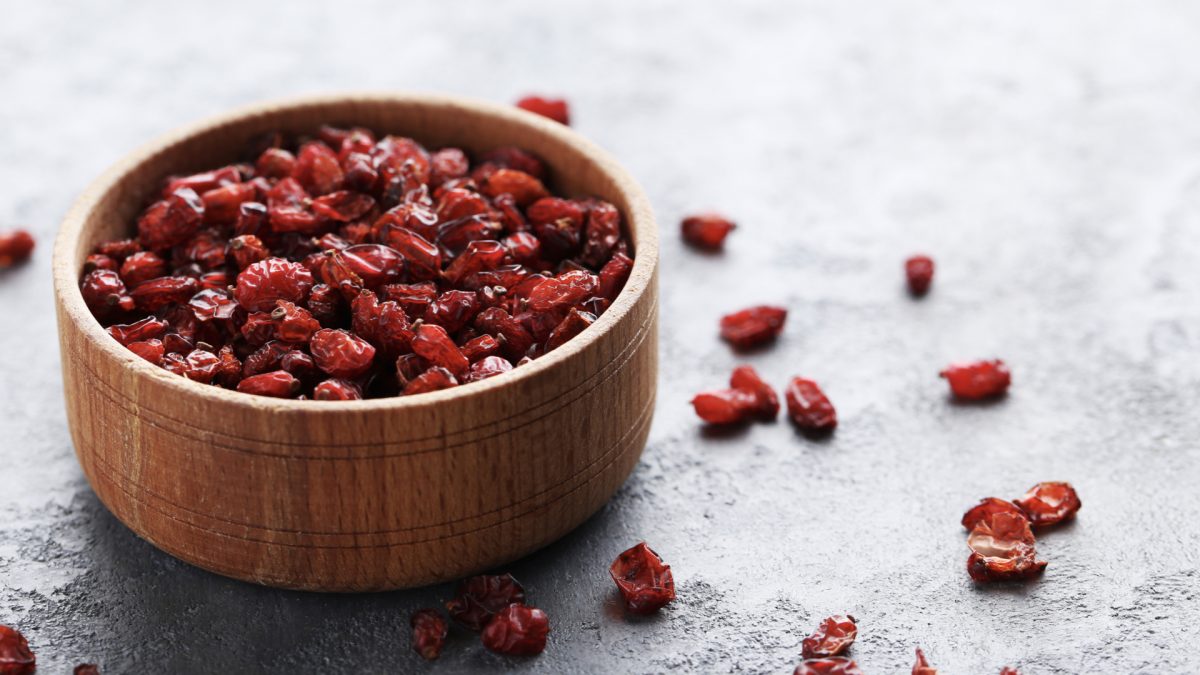We hear a lot about traditional Chinese herbal medicine, but less about the herbs used in Japan. There is a root called Rhizoma coptidis that appears to have similar anti-acne activities to drugs like Accutane, a drug infamous for its side effects that has been since pulled from the market. But there are side effects to the root, too. A poor fellow took it to clear up his skin and as you can see in my video, let’s just say it made things worse.
The anti-acne active component of the root is thought to be berberine. Is there any way to get the active ingredient in a safer plant? Yes, apparently: barberries, which I cover in my video Treating Acne with Barberries. You may remember barberries as being perhaps the most antioxidant-packed dried fruit available (see my video Better Than Goji Berries). You can find them cheap at Middle Eastern grocers, since they’re used to make a signature Persian rice dish. Their taste is described as “pleasantly acidulous,” which is just doctor-speak for sour. I love sprinkling them on my oatmeal just because I love their taste, but, evidently, they have played a prominent role in herbal healing for thousands of years around the world. They have been described rather flamboyantly in a pharmacology journal as an “herbal remedy [that] has no match in serving the human race.” And I just thought they were kind of tangy.
The problem with the herbal medicine literature is that there is often a long, impressive list of traditional uses, but little or no science to back them up. And what does exist is often either test tube or animal data that has questionable clinical applicability. Who cares, for example, if barberries “induce menstruation in a guinea pig” (except maybe the guinea pig)? So, you end up with drug companies injecting herbs into the penises of rabbits in hopes of coming up with the next Viagra, but they conduct few, if any, human studies.
I’ve seen petri dish studies over the years suggesting anti-cancer effects of barberries on human tumor cells in a petri dish or having anti-acne effects on hamsters, but there weren’t any such human studies… until, now.
Evidently, there had been anecdotal reports of acne clearing up after barberry juice consumption, so researchers decided to put it to the test in a double-blind, randomized, placebo-controlled clinical trial of fifty 12- to 17-year-olds with moderate to severe acne. Half got a sugar pill, and the other half got the equivalent of about a teaspoon of dried barberries three times a day for a month.
The results were remarkable. After four weeks on the placebo, as expected there was no change. The teens had just as many pimples as before. But in the barberry group, there was a 43 percent drop in the number of zits and about a 45 percent drop in the number of inflamed zits. That’s extraordinary. A spoonful of dried barberries costs about eight cents. Barberries have no reported side effects, and they are healthy for you anyway. The only potential concerns I could find were about eating them during pregnancy, and we don’t have good data on barberry consumption during lactation, so it’s best to stay away from barberries during breastfeeding as well until we know more.
For more on acne check out these older videos:
- Skim Milk and Acne
- National Dairy Council on Acne and Milk
- The Acne-Promoting Effects of Milk
- Saving Lives by Treating Acne with Diet
And a few new ones I just released this year:
In health,
Michael Greger, M.D.
PS: If you haven’t yet, you can subscribe to my free videos here and watch my live, year-in-review presentations:
- 2012: Uprooting the Leading Causes of Death
- 2013: More Than an Apple a Day
- 2014: From Table to Able: Combating Disabling Diseases with Food
- 2015: Food as Medicine: Preventing and Treating the Most Dreaded Diseases with Diet
- 2016: How Not To Die: The Role of Diet in Preventing, Arresting, and Reversing Our Top 15 Killers
